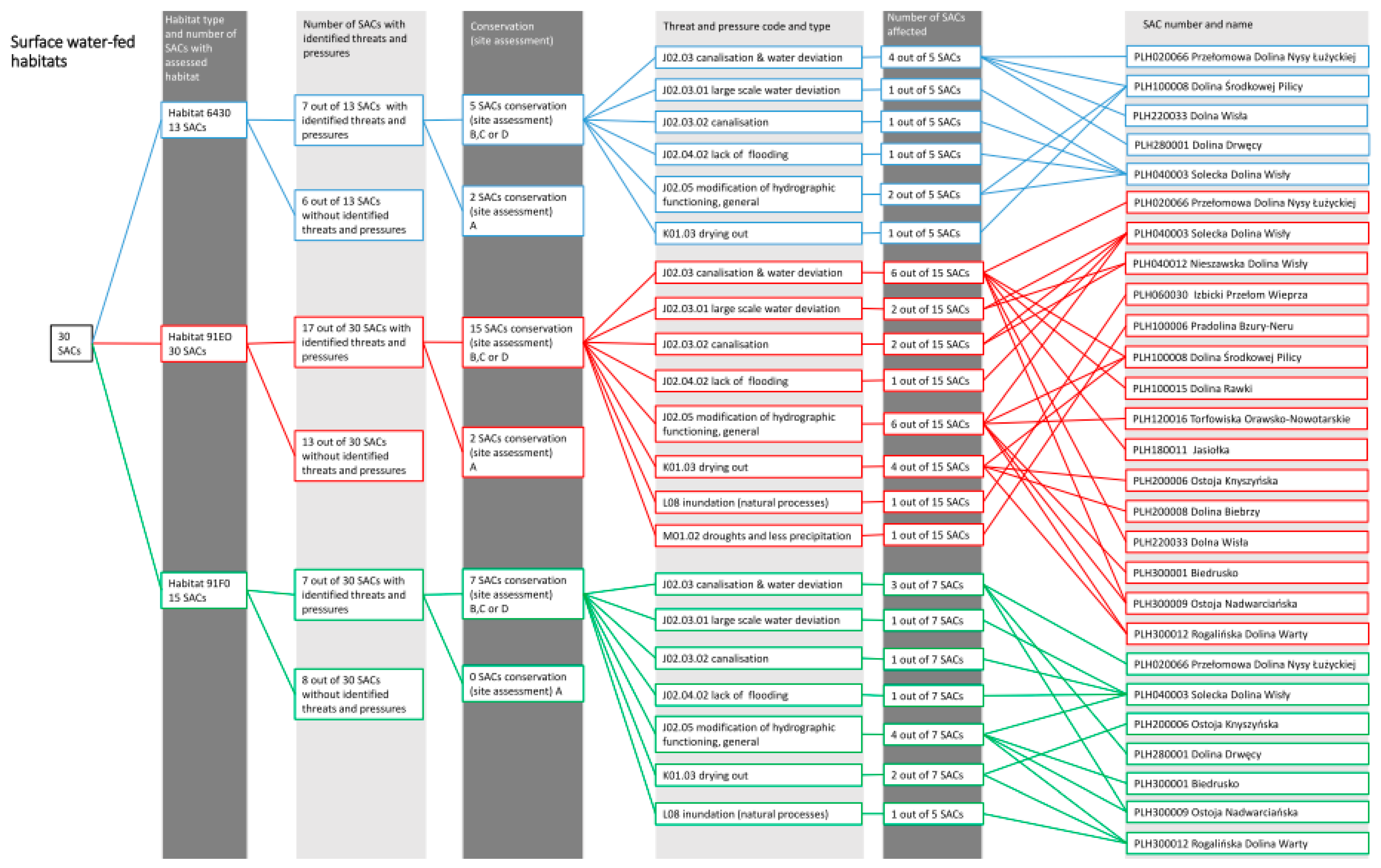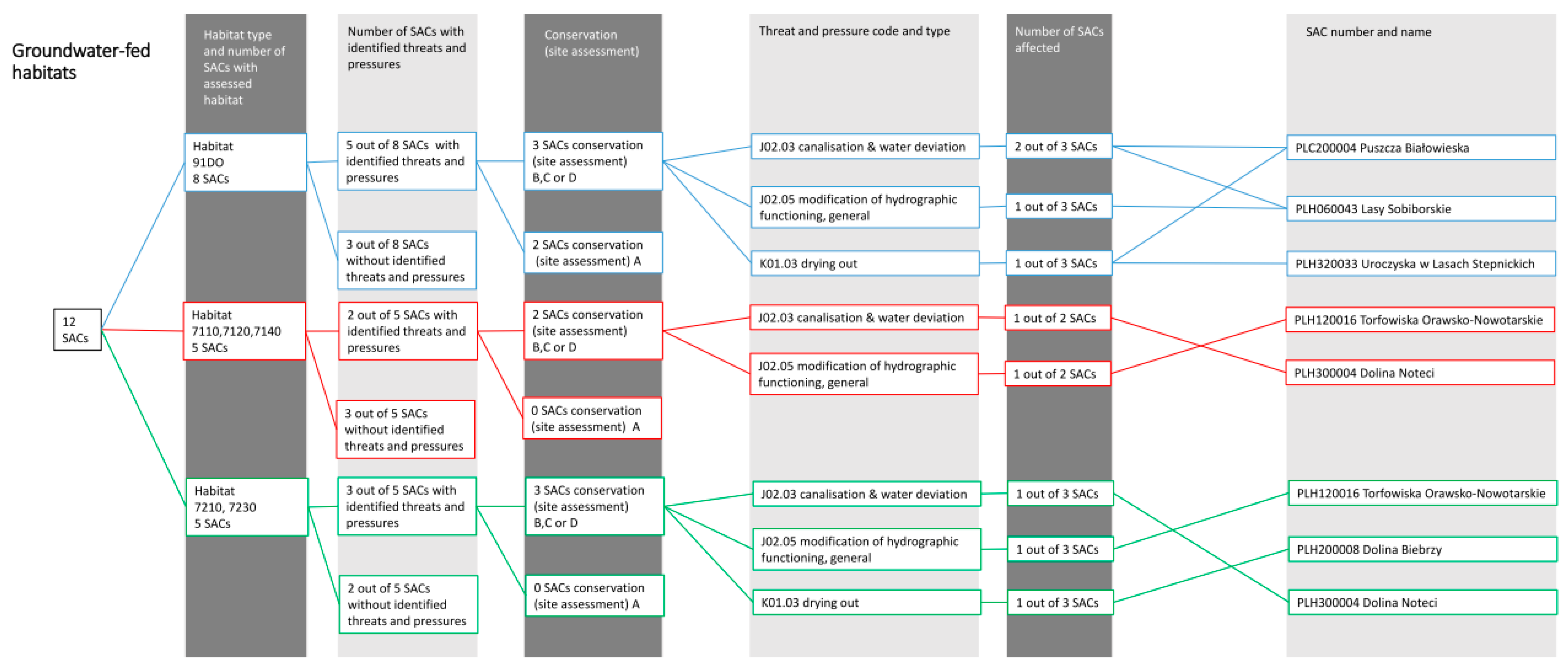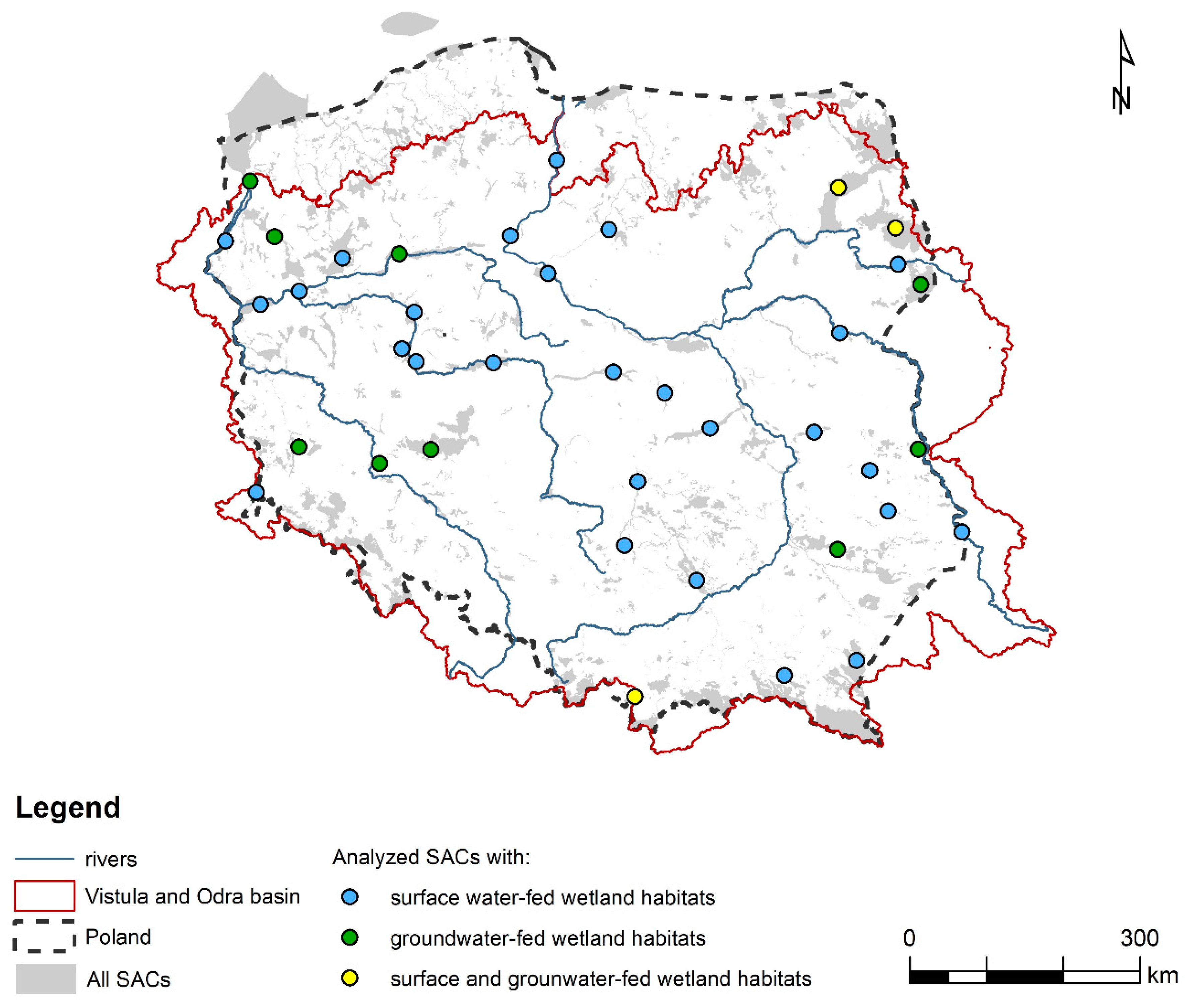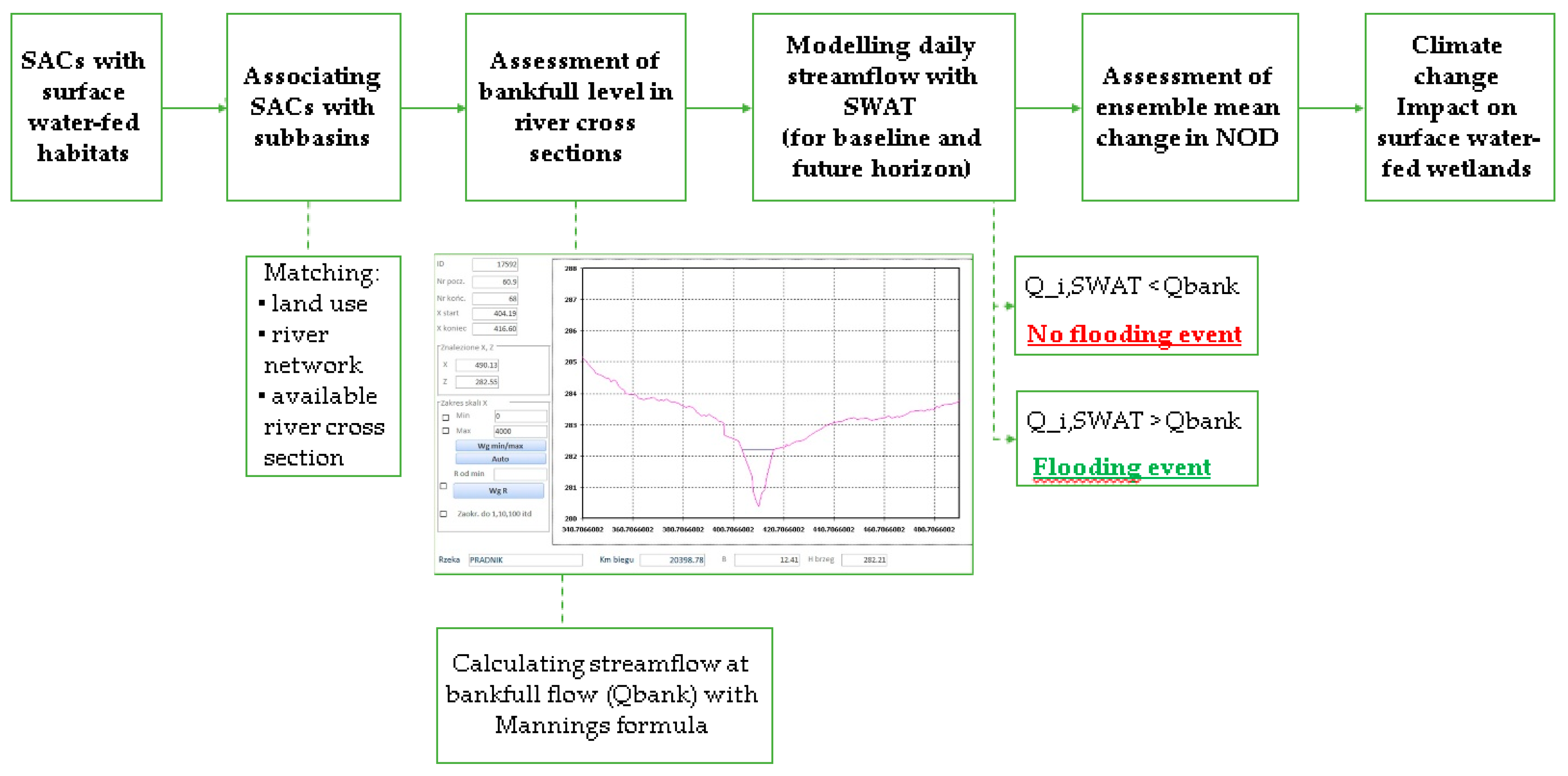Modelling Climate Change’s Impact on the Hydrology of Natura 2000 Wetland Habitats in the Vistula and Odra River Basins in Poland
Abstract
1. Introduction
2. Materials and Methods
2.1. Study Area
2.2. Classes of Wetlands according to Hydrological Characteristics
2.2.1. Wetlands with a Dominant Role of Surface Water
2.2.2. Wetlands with a Dominant Role of Groundwater
2.3. Data on Wetland Habitats in Poland
2.4. Hydrological Modelling Approach
2.4.1. Modelling with the Use of SWAT
2.4.2. Climate Change Scenarios
2.4.3. Assessment of Flooding Events
2.4.4. Soil Water Assessment
2.4.5. Analysis of the Current Conservation Status, Threats, and Pressures Affecting Habitats
3. Results
3.1. Climate Change’s Effect on Surface Water-Fed Wetlands
3.2. Climate Change Effect on Groundwater-Fed Wetlands
3.3. Current Habitat Conservation Status, Threats, and Pressures
4. Discussion
4.1. Change in the Habitat Conservation Status
4.2. Impact on Analyzed Habitats
5. Conclusions
Author Contributions
Funding
Acknowledgments
Conflicts of Interest
Appendix A


References
- Maltby, E. Waterlogged Wealth: Why Waste the World’s Wet Places? International Institute for Environment and Development: London, UK, 1986; ISBN 0905347633. [Google Scholar]
- Bullock, A.; Acreman, M. The role of wetlands in the hydrological cycle. Hydrol. Earth Syst. Sci. 2003, 7, 358–389. [Google Scholar] [CrossRef]
- Verhoeven, J.T.A.; Arheimer, B.; Yin, C.; Hefting, M.M. Regional and global concerns over wetlands and water quality. Trends Ecol. Evol. 2006, 21, 96–103. [Google Scholar] [CrossRef]
- Acreman, M.C.; Miller, F. Practical approaches to hydrological assessment of wetlands lessons from the UK. In Wetlands: Monitoring, Modelling and Management; Okruszko, T., Maltby, E., Szatyłowicz, J., Świątek, D., Kotowski, W., Eds.; Taylor & Francis: London, UK, 2007. [Google Scholar]
- Okruszko, T.; Duel, H.; Acreman, M.; Grygoruk, M.; Flörke, M.; Schneider, C. Broad-scale ecosystem services of European wetlands—Overview of the current situation and future perspectives under different climate and water management scenarios. Hydrol. Sci. J. 2011, 56, 1501–1517. [Google Scholar] [CrossRef]
- Côté, I.M.; Darling, E.S. Rethinking ecosystem resilience in the face of climate change. PLoS Biol. 2010, 8, e1000438. [Google Scholar] [CrossRef]
- IPCC. Summary for Policymakers. In Climate Change 2014: Mitigation of Climate Change. Contribution of Working Group III to the Fifth Assessment Report of the Intergovernmental Panel on Climate Change; Edenhofer, O.R., Pichs-Madruga, Y., Sokona, E., Farahani, S., Kadner, K., Seyboth, A., Adler, I., Baum, S., Brunner, P., Eickemeier, B., et al., Eds.; Cambridge University Press: Cambridge, UK; New York, NY, USA, 2014. [Google Scholar]
- Jacob, D.; Petersen, J.; Eggert, B.; Alias, A.; Christensen, O.B.; Bouwer, L.M.; Braun, A.; Colette, A.; Déqué, M.; Georgievski, G.; et al. EURO-CORDEX: New high-resolution climate change projections for European impact research. Reg. Environ. Chang. 2014, 14, 563–578. [Google Scholar] [CrossRef]
- Roudier, P.; Andersson, J.C.M.; Donnelly, C.; Feyen, L.; Greuell, W.; Ludwig, F. Projections of future floods and hydrological droughts in Europe under a +2 °C global warming. Clim. Chang. 2016, 135, 341–355. [Google Scholar] [CrossRef]
- Alfieri, L.; Burek, P.; Feyen, L.; Forzieri, G. Global warming increases the frequency of river floods in Europe. Hydrol. Earth Syst. Sci. 2015, 19, 2247–2260. [Google Scholar] [CrossRef]
- Candela, L.; Von Igel, W.; Elorza, F.J.; Aronica, G. Impact assessment of combined climate and management scenarios on groundwater resources and associated wetland (Majorca, Spain). J. Hydrol. 1997, 376, 510–527. [Google Scholar] [CrossRef]
- Schneider, C.; Flörke, M.; De Stefano, L.; Petersen-Perlman, J.D. Hydrological threats to riparian wetlands of international importance—A global quantitative and qualitative analysis. Earth Syst. Sci 2017, 215194, 2799–2815. [Google Scholar] [CrossRef]
- Schneider, C.; Flörke, M.; Geerling, G.; Duel, H.; Grygoruk, M.; Okruszko, T. The future of European floodplain wetlands under a changing climate. J. Water Clim. Chang. 2011, 2, 106–122. [Google Scholar] [CrossRef]
- House, A.R.; Thompson, J.R.; Acreman, M.C. Projecting impacts of climate change on hydrological conditions and biotic responses in a chalk valley riparian wetland. J. Hydrol. 2016, 534, 178–192. [Google Scholar] [CrossRef]
- Holsten, A.; Vetter, T.; Vohland, K.; Krysanova, V. Impact of climate change on soil moisture dynamics in Brandenburg with a focus on nature conservation areas. Ecol. Model. 2009, 220, 2076–2087. [Google Scholar]
- Dembek, W.; Grotek, A.; Jakubowski, W.; Piórkowska, H.; Oświecimska-Piasko, Z.; Siedlecki, T.; Szewczyk, M. System Informacji Przestrzennej o Mokradłach Polski “GIS-Mokradła”; IMUZ: Falenty, Poland, 2006. [Google Scholar]
- Statistics Poland. Statistical Analyses Environment 2018; GUS: Warsaw, Poland, 2018; ISBN 0867-3217.
- Okruszko, T.; Kiczko, A. Assessment of Water Requirements of “Swamp Communities: The River Narew Case Study. Publ. Inst. Geophys. Pol. Acad. Sci. 2008, E-9, 27–39. [Google Scholar]
- Dembek, W.; Pawlaczyk, P.; Sienkiewicz, J.D.P. Obszary Wodno-Błotne w Polsce; IMUZ: Falenty, Poland, 2004. [Google Scholar]
- EU. Council Directive 92/43/EEC of 21 May 1992 on the Conservation of Natural Habitats and of Wild Fauna and Flora; EU: Brussels, Belgium, 1992. [Google Scholar]
- GDEP. Spatial Information Database of Natura 2000 sites and habitats prepared by General Directorate for Environmental Protection (GDEP); GDEP: Warsaw, Poland, 2016. Available online: https://natura2000.gdos.gov.pl/ (accessed on 9 September 2018).
- Arnold, J.G.; Srinivasan, R.; Muttiah, R.S.; Williams, J.R. Large area hydrologic modeling and assessment part I: Model development. J. Am. Water Resour. Assoc. 1998, 34, 73–89. [Google Scholar] [CrossRef]
- Piniewski, M.; Szcześniak, M.; Kardel, I.; Berezowski, T.; Okruszko, T.; Srinivasan, R.; Vikhamar Schuler, D.; Kundzewicz, Z.W. Hydrological modelling of the Vistula and Odra river basins using SWAT. Hydrol. Sci. J. 2017, 62, 1266–1289. [Google Scholar] [CrossRef]
- Mezghani, A.; Dobler, A.; Haugen, J.E.; Benestad, R.E.; Parding, K.M.; Piniewski, M.; Kardel, I.; Kundzewicz, Z.W. CHASE-PL Climate Projection dataset over Poland – bias adjustment of EURO-CORDEX simulations. Earth Syst. Sci. Data 2017, 95194, 905–925. [Google Scholar] [CrossRef]
- Moss, R.H.; Edmonds, J.A.; Hibbard, K.A.; Manning, M.R.; Rose, S.K.; van Vuuren, D.P.; Carter, T.R.; Emori, S.; Kainuma, M.; Kram, T.; et al. The next generation of scenarios for climate change research and assessment. Nature 2010, 463, 747–756. [Google Scholar] [CrossRef]
- Piniewski, M.; Mezghani, A.; Szcześniak, M.; Kundzewicz, Z. Regional projections of temperature and precipitation changes: Robustness and uncertainty aspects. Meteorol. Zeitschrift 2017, 26, 223–234. [Google Scholar] [CrossRef]
- Hughes, F.M.R. Floodplain biogeomorphology. Prog. Phys. Geogr. Earth Environ. 1997, 21, 501–529. [Google Scholar] [CrossRef]
- Schneider, C.; Flörke, M.; Eisner, S.; Voss, F. Large scale modelling of bankfull flow: An example for Europe. J. Hydrol. 2011, 408, 235–245. [Google Scholar] [CrossRef]
- Tockner, K.; Malard, F.; Ward, J.V. An extention of the flood pulse concept. Hydrol. Proc. 2000, 14, 2861–2883. [Google Scholar] [CrossRef]
- Cooper, D.J.; Merritt, D.M. Assessing the Water Needs of Riparian and Wetland Vegetation in the Western United States; US Department of Agriculture, Forest Service, Rocky Mountain Research Station: Fort Collins, CO, USA, 2012. [Google Scholar]
- Smith, J.A.C.; Griffiths, H. Water Deficits: Plant Responses from Cell to Community; Bios Scientific Publishers: Oxford, UK, 1993; ISBN 1-872748-06-5. [Google Scholar]
- Gerten, D.; Schaphoff, S.; Lucht, W. Potential future changes in water limitations of the terrestrial biosphere. Clim. Chang. 2007, 80, 277–299. [Google Scholar] [CrossRef]
- KZGW. Baza Danych Przekroi Mokrych Rzek Polski Wykonana w Ramach Projektu “Informatyczny System Osłony Kraju Przed Nadzwyczajnymi Zagrożeniami” (ISOK); KZGW: Warsaw, Poland, 2014.
- Leopold, L.B.; Wolman, M.G.; Miller, J.P. Fluvial Processes in Geomorphology; Dover Publications, Inc.: New York, NY, USA, 1964. [Google Scholar]
- Maltby, E. Functional Assessment of Wetlands: Towards Evaluation of Ecosystem Services; Woodhead Publishing Limited: Cambridge, UK, 2009; ISBN 9781855738348. [Google Scholar]
- Stephenson, N. Climatic control of vegetation distribution: The role of the water balance. Am. Nat. 1990, 135, 649–670. [Google Scholar] [CrossRef]
- Yang, Y.; Watanabe, M.; Wang, Z.; Sakura, Y.; Tang, C. Prediction Of Changes In Soil Moisture Associated With Climatic Changes And Their Implications For Vegetation Changes: Waves Model Simulation On Taihang Mountain, China. Clim. Chang. 2003, 57, 163–183. [Google Scholar] [CrossRef]
- Arnold, J.G.; Kiniry, J.R.; Srinivasan, R.; Williams, J.R.; Haney, E.B.; Neitsch, S.L. Soil and Water Assessment Tool Input/Output Documentation; Texas Water Resources Institute: College Station, TX, USA, 2012. [Google Scholar]
- Andreadis, K.M.; Clark, E.A.; Wood, A.W.; Hamlet, A.F.; Lettenmaier, D.P. Twentieth-Century Drought in the Conterminous United States. J. Hydrometeorol. 2006, 6, 985–1001. [Google Scholar] [CrossRef]
- EC. Natura 2000 Standard Data Form: Explanatory Notes; European Comission: Brussels, Belgium, 2011. [Google Scholar]
- Cowx, I.G.; Fraser, D. Monitoring the Atlantic Salmon Salmo Salar; English Nature: Peterborough, UK, 2000.
- EC. Wildlife and Sustainable Farming and the Birds and Habitats Directives: How Species Conservation Can Be Supported through Rural Development Programmes—Good Practice Examples; European Comission: Brussels, Belgium, 2009. [Google Scholar]
- Marcinkowski, P.; Piniewski, M.; Kardel, I.; Szcześniak, M.; Benestad, R.; Srinivasan, R.; Ignar, S.; Okruszko, T. Effect of Climate Change on Hydrology, Sediment and Nutrient Losses in Two Lowland Catchments in Poland. Water 2017, 9, 156. [Google Scholar] [CrossRef]
- Piniewski, M.; Szcześniak, M.; Kundzewicz, Z.W.; Mezghani, A.; Hov, Ø. Changes in low and high flows in the Vistula and the Odra basins: Model projections in the European-scale context. Hydrol. Process. 2017, 31, 2210–2225. [Google Scholar] [CrossRef]
- Schneider, C.; Laizé, C.L.R.; Acreman, M.C.; Flörke, M. How will climate change modify river flow regimes in Europe? Hydrol. Earth Syst. Sci. 2013, 17, 325–339. [Google Scholar] [CrossRef]
- Dankers, R.; Feyen, L. Climate change impact on flood hazard in Europe: An assessment based on high-resolution climate simulations. J. Geophys. Res. 2008, 113, D19105. [Google Scholar] [CrossRef]
- Kundzewicz, Z.W.; Krysanova, V.; Dankers, R.; Hirabayashi, Y.; Kanae, S. Differences in flood hazard projections in Europe-their causes and consequences for decision making. Hydrol. Sci. J. 2017, 62, 1–14. [Google Scholar] [CrossRef]
- Dwire, K.A.; Mellmann-Brown, S.; Gurrieri, J.T. Potential effects of climate change on riparian areas, wetlands, and groundwater-dependent ecosystems in the Blue Mountains, Oregon, USA. Clim. Serv. 2017, 10, 44–52. [Google Scholar] [CrossRef]
- Jones, A.; Stolbovoy, V.; Rusco, E.; Gentile, A.-R.; Gardi, C.; Marechal, B.; Montanarella, L. Climate change in Europe. 2. Impact on soil. A review. Agron. Sustain. Dev. 2009, 29, 423–432. [Google Scholar] [CrossRef]
- Mihailović, D.T.; Drešković, N.; Arsenić, I.; Ćirić, V.; Djurdjević, V.; Mimić, G.; Pap, I.; Balaž, I. Impact of climate change on soil thermal and moisture regimes in Serbia: An analysis with data from regional climate simulations under SRES-A1B. Sci. Total Environ. 2016, 571, 398–409. [Google Scholar] [CrossRef]
- Webb, J.A.; Wallis, E.M.; Stewardson, M.J. A systematic review of published evidence linking wetland plants to water regime components. Aquat. Bot. 2012, 103, 1–14. [Google Scholar] [CrossRef]
- Maclean, I.M.D.; Bennie, J.J.; Scott, A.J.; Wilson, R.J. A high-resolution model of soil and surface water conditions. Ecol. Model. 2012, 237–238, 109–119. [Google Scholar] [CrossRef]
- Alcamo, J.; Döll, P.; Henrichs, T.; Kaspar, F.; Lehner, B.; Rösch, T.; Siebert, S. Global estimates of water withdrawals and availability under current and future “business-as-usual” conditions. Hydrol. Sci. J. 2003, 48, 339–348. [Google Scholar] [CrossRef]
- Foley, J.A.; Defries, R.; Asner, G.P.; Barford, C.; Bonan, G.; Carpenter, S.R.; Chapin, F.S.; Coe, M.T.; Daily, G.C.; Gibbs, H.K.; et al. Global Consequences of Land Use. Science 2005, 309, 570–574. [Google Scholar] [CrossRef]
- Neilson, R.P. Model for predicting continental-scale vegetation distribution and water balance—ScienceBase-Catalog. Ecol. Appl. 1995, 5, 362–385. [Google Scholar] [CrossRef]
- Oki, T.; Kanae, S. Global hydrological cycles and world water resources. Science 2006, 313, 1068–1072. [Google Scholar] [CrossRef]
- Richter, B.D.; Richter, H.E. Prescribing Flood Regimes to Sustain Riparian Ecosystems along Meandering Rivers. Conserv. Biol. 2000, 14, 1467–1478. [Google Scholar] [CrossRef]
- Glenz, C.; Schlaepfer, R.; Iorgulescu, I.; Kienast, F. Flooding tolerance of Central European tree and shrub species. For. Ecol. Manag. 2006, 235, 1–13. [Google Scholar] [CrossRef]
- Wheeler, B.D.; Gowing, D.J.G.; Shaw, S.C.; Mountford, J.O.; Money, R.P. Ecohydrological Guidelines for Lowland Wetland Plant Communities; Brooks, A.W., Jose, P.V., Whiteman, M.I., Eds.; Environment Agency Kingfisher House: Peterborough, UK, 2004.
- Barsoum, N.; Anderson, R.; Broadmeadow, S.; Bishop, T.N.H. Eco-Hydrological Guidelines for Wet Woodland—Phase 1; English Nature: Peterborough, UK, 2001; pp. 1990–2001.





| Natura 2000 Habitats (With Codes) | Surface Water-Fed | Groundwater-Fed |
|---|---|---|
| Wetlands | ||
| 7110—Active raised bogs | • | |
| 7120—Degraded raised bogs still capable of natural regeneration | • | |
| 7140—Transition mires and quaking bogs | • | |
| 7150—Depressions on peat substrates of the Rhynchosporion | • | |
| 7210—Calcareous fens with Cladium mariscus and species of the Caricion davallianae | • | |
| 7220—Petrifying springs with tufa formation (Cratoneurion) | • | |
| 7230—Alkaline fens | • | |
| Heaths, meadows | ||
| 4010—Northern Atlantic wet heaths with Erica tetralix | • | |
| 6410—Molinia meadows on calcareous, peaty or clayey-silt-laden soils (Molinion caeruleae) | • | |
| 6430—Hydrophilous tall herb fringe communities of plains and of the montane to alpine levels | • | |
| Forests and woodlands | ||
| 91D0—Bog woodland | • | |
| 91E0—Alluvial forests with Alnus glutinosa and Fraxinus excelsior (Alno-Padion, Alnion incanae, Salicion albae) | • | |
| 91F0—Riparian mixed forests of Quercus robur, Ulmus laevis and Ulmus minor, Fraxinus excelsior or Fraxinus angustifolia, along the large rivers (Ulmenion minoris) | • |
| Type of Water Supply | Natura 2000 Habitats | Average Area (km2) | Total Area (km2) | Share of Wetland Habitat Area in Poland Analysed in This Project (%) | ||
|---|---|---|---|---|---|---|
| Code | Poland | Project | Poland | Project | ||
| Surface water-fed | 6430 | 0.02 | 0.03 | 15.76 | 1.80 | 11.40 |
| 91E0 | 0.02 | 0.04 | 1437.49 | 231.45 | 16.10 | |
| 91F0 | 0.03 | 0.08 | 347.65 | 46.34 | 13.33 | |
| Groundwater-fed | 91D0 | 0.03 | 0.04 | 649.16 | 74.47 | 11.47 |
| 7110 | 0.03 | 0.08 | 51.35 | 6.27 | 12.22 | |
| 7120 | 0.03 | 0.14 | 23.84 | 7.48 | 31.37 | |
| 7140 | 0.02 | 0.04 | 153.34 | 14.78 | 9.64 | |
| 7210 | 0.08 | 0.15 | 15.26 | 0.92 | 6.01 | |
| 7230 | 0.03 | 0.04 | 23.18 | 5.84 | 25.19 | |
| Type of Water Supply | Habitat Type | No. of Analyzed Sub-Basins | No. of Analyzed HRU | No. of Analyzed SACs | No. of SACs with Identified Threats and Pressures | Threat of Drying Out | Threat of Inundation | ||||||
|---|---|---|---|---|---|---|---|---|---|---|---|---|---|
| No. of Analyzed Sub-Basins or HRU (B, C, D) | No. of Threats (B, C, D) | No. of Analyzed Sub-Basins or HRU (A) | No. of Threats (A) | No. of Analyzed Sub-Basins or HRU (B, C, D) | No. of Threats (B, C, D) | No. of Analyzed Sub-Basins or HRU (A) | No. of Threats (A) | ||||||
| Surface water-fed | 6430 | 13 | 13 | 7 | 5 | 10 | 2 | 2 | 0 | 0 | 0 | 0 | |
| 91E0 | 30 | 30 | 17 | 14 | 22 | 1 | 1 | 1 | 1 | 1 | 1 | ||
| 91F0 | 15 | 15 | 7 | 7 | 12 | 0 | 0 | 0 | 0 | 0 | 0 | ||
| Groundwater-fed | Bog woodlands 91D0 | 34 | 8 | 5 | 3 | 5 | 2 | 2 | 0 | 0 | 0 | 0 | |
| Bogs (7110, 7120 and 7140) | 8 | 5 | 2 | 2 | 2 | 0 | 0 | 0 | 0 | 0 | 0 | ||
| Fens (7210 and 7230) | 10 | 5 | 3 | 3 | 3 | 0 | 0 | 0 | 0 | 0 | 0 | ||
| Components of Water Regime | Plant Assemblage Composition | Plant Diversity |
|---|---|---|
| Waterlogging | Insufficient evidence | Insufficient evidence |
| Inundation | Inundation affects plant assemblage composition | Inundation decreases plant diversity |
| Duration of inundation | Inundation duration affects plant assemblage composition | Increasing flood duration does not increase plant diversity |
© 2019 by the authors. Licensee MDPI, Basel, Switzerland. This article is an open access article distributed under the terms and conditions of the Creative Commons Attribution (CC BY) license (http://creativecommons.org/licenses/by/4.0/).
Share and Cite
O’Keeffe, J.; Marcinkowski, P.; Utratna, M.; Piniewski, M.; Kardel, I.; Kundzewicz, Z.W.; Okruszko, T. Modelling Climate Change’s Impact on the Hydrology of Natura 2000 Wetland Habitats in the Vistula and Odra River Basins in Poland. Water 2019, 11, 2191. https://doi.org/10.3390/w11102191
O’Keeffe J, Marcinkowski P, Utratna M, Piniewski M, Kardel I, Kundzewicz ZW, Okruszko T. Modelling Climate Change’s Impact on the Hydrology of Natura 2000 Wetland Habitats in the Vistula and Odra River Basins in Poland. Water. 2019; 11(10):2191. https://doi.org/10.3390/w11102191
Chicago/Turabian StyleO’Keeffe, Joanna, Paweł Marcinkowski, Marta Utratna, Mikołaj Piniewski, Ignacy Kardel, Zbigniew W. Kundzewicz, and Tomasz Okruszko. 2019. "Modelling Climate Change’s Impact on the Hydrology of Natura 2000 Wetland Habitats in the Vistula and Odra River Basins in Poland" Water 11, no. 10: 2191. https://doi.org/10.3390/w11102191
APA StyleO’Keeffe, J., Marcinkowski, P., Utratna, M., Piniewski, M., Kardel, I., Kundzewicz, Z. W., & Okruszko, T. (2019). Modelling Climate Change’s Impact on the Hydrology of Natura 2000 Wetland Habitats in the Vistula and Odra River Basins in Poland. Water, 11(10), 2191. https://doi.org/10.3390/w11102191






